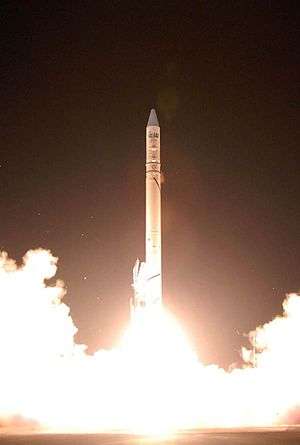Ofeq
Ofeq, also spelled Offek or Ofek (Hebrew: אופק, lit. Horizon) is the designation of a series of Israeli reconnaissance satellites first launched in 1988. Most Ofeq satellites have been carried on top of Shavit rockets from Palmachim Airbase in Israel, on the Mediterranean coast. The Low Earth orbit satellites complete one earth orbit every 90 minutes. The satellite launches made Israel the eighth nation to gain an indigenous launch capability. Both the satellites and the launchers were designed and manufactured by Israel Aerospace Industries (IAI) with Elbit Systems' El-Op division supplying the optical payload.
 Ofeq 7 launch utilising the Shavit vehicle | |
| Manufacturer | IAI |
|---|---|
| Country of origin | |
| Operator | Israeli Ministry of Defence |
| Specifications | |
| Regime | Low Earth |
| Production | |
| Status | Active |
| Built | 11 known (including Ofeq 8) |
| Launched | 11 (including Ofeq 8) |
| Maiden launch | Ofeq 1, 1988-09-19 |
| Last launch | Ofek-11, 2016-09-13 |
Description
While exact technical details and capabilities are classified, it is assumed that the Ofeq satellites have ultraviolet and visible imaging sensors, and an effective operational lifespan of 1–3 years. Some early reports stated the reconnaissance capabilities as such that would allow "reading license plates in Baghdad", but that can be ruled out on grounds of physical optics. Other reports more plausibly place the imaging resolution at 0.8 meters for Ofeq 5.
Most non-Israeli satellites are launched eastward to gain a boost from the Earth's rotational speed. However, Ofeq satellites are launched westward (in retrograde orbits) over the Mediterranean to avoid flying over, and dropping spent rocket stages over, populated land areas. Other Israeli satellites (such as the Amos series) are launched from locations in other countries.[1]
Ofeq's east-to-west orbit of about 141 degrees orbital inclination[2] is phased to give good daylight coverage of the Middle East. Ofeq makes a half-dozen or so daylight passes per day over Israel and the surrounding countries, whereas U.S. and Russian spysats only get one or two passes per day from their higher inclination orbits.
Launch history [3]
- Ofeq 1, launched September 19, 1988, possessed a weight of 155 kg and circled the earth on an orbit with a perigee of 249 km and an apogee of 1149 km on a course bent around 142.9 degrees. It accomplished mainly solar cell and radio transmission tests.
- Ofeq 2, was launched April 23, 1990 on a course with a perigee of 149 km and an apogee of 251 km, bent around 143.2 degrees. It also accomplished communication tests.
- The launch of Ofeq 3 series was initially postponed from September 15, 1994, to April 5, 1995.[4]
- Ofeq 3, launched April 5, 1995, was the first operational Israeli satellite with reconnaissance (photography) capabilities. It weighed 225 kg and had a perigee of 369 km and was launched on a new version of Shavit.
- Ofeq 4, launched January 22, 1998, did not achieve earth orbit due to a launcher failure and was lost.
- Ofeq 5, was launched 28 May 2002. The 300 kg Ofeq 5 orbited the earth on a course with a perigee of 262 km and an apogee of 774 km, bent around 143.5 degrees. During the course of its mission, its perigee was raised to 369 km and its apogee was lowered to 771 kilometers, in an attempt to prolong the satellite's lifespan. Some observers believe that the 300 kg weight of the satellite, combined with the additional propulsive requirements of the retrograde orbit, constitute a de facto demonstration of the Shavit's ICBM potential.
- Ofeq 6, launched September 6, 2004 encountered another launcher failure, failed to achieve low earth orbit and crashed to the sea. The launcher failure was due to the third stage of the Shavit launcher.
- Ofeq 7 was successfully launched on June 11, 2007 using the Shavit launcher.[5]
- Ofeq 8 designation is used for the TecSAR synthetic aperture radar satellite launched by an Indian rocket on 21 January 2008.[6]
- Ofeq 9 was successfully launched on June 22, 2010 from Palmachim Air Base using the upgraded Shavit launcher.[6][7]
- Ofeq 10, providing high-resolution synthetic aperture radar, was successfully launched on April 9, 2014 from Palmachim Air Base using the upgraded Shavit launcher.[2]
- Ofeq 11 was successfully launched on September 13, 2016 from Palmachim Air Base using the upgraded Shavit launcher.[8]
References
- "AMOS 1 → Intelsat 24". space.skyrocket.de. Retrieved 2019-08-19.
- Stephen Clark (10 April 2014). "All-weather surveillance satellite put in orbit by Israel". Spaceflight Now. Retrieved 12 April 2014.
- Ed Kyle. "Space Launch Report: Shavit". Space Launch Report. Archived from the original on 21 December 2019. Retrieved 10 January 2020.
- Shavit Federation of American Scientists
- "Israel successfully launches Ofek 7 satellite". Israel Ministry of Foreign Affairs.
- Opall-Rome, Barbara (22 June 2010). "Israel Launches Ofeq-9 Satellite". Defense News. Archived from the original on 7 September 2012. Retrieved 22 June 2010.
- "Israel Launches New Spy Satellite, Ofek 11". Haaretz.